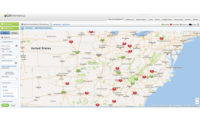For more than 30 years, H&M Bay has delivered nationwide temperature-controlled freight solutions. Headquartered in Federalsburg, Md., with six additional facilities across the United States, H&M Bay has an owner/operator network of more than 10,000 refrigerated and frozen less-than-truckload (LTL) carriers.
Challenges
For a cold storage provider whose goal is to quickly and efficiently load and unload trucks of temperature-controlled freight, a pallet tracking system is an absolute necessity. H&M Bay’s Federalsburg facility had long relied on a radio frequency identification (RFID) system to track pallets moving in and out of its warehouse. However, this system posed several issues. Often, it picked up the wrong tag or did not read the tag at all, since pallets were stacked and moved around via lifts. In these cases, employees had to manually enter pallet numbers into their lift computers. Yet, even if the tag was read properly, the process was slow. If it took too long to read the tag, workers would either manually enter the information or re-position the pallet and wait again for the reader to detect it. Also, readers and printers required frequent re-boots, which further affected productivity.
Although the RFID system was sufficient for the Federalsburg facility, H&M Bay wanted to look for an alternative solution when it began building a new cold storage facility in Uxbridge, Mass. With the facility 400 miles away, H&M Bay’s IT staff could not easily support the technology if problems arose. So, the company sought a cost-effective system that would more accurately and efficiently track pallets to quickly load/unload frozen freight.
Solution
H&M Bay turned to Barcoding, Inc., a leader in supply chain efficiency, accuracy and connectivity. The Baltimore, Md.-based systems integrator helped H&M Bay to implement a barcode scanning system consisting of Zebra LS3408er handheld scanners, Honeywell PX6i printers, Zebra rugged vehicle mount computers and Honeywell barcode labels. Although Barcoding provides RFID systems, it also understands the importance of matching the solution to the use case. In some instances – for example, if pallets were moving through a threshold one at a time on a conveyor belt – RFID may be the best-suited technology. However, for H&M Bay’s specific application, barcodes fit the bill.
The barcode system works the same as the previous system, but provides greater pallet control. When a truck arrives at one of H&M Bay’s four receiving stations, pallets are unloaded one at a time. A worker reviews an electronic copy of a pallet’s load sheet, verifies that it is in an acceptable condition, clicks on the order and enters the number of cases on the pallet into a custom web-based software application. A barcode label identifying the pallet is automatically printed and attached to the pallet, which is then moved into cold storage by a lift. From the lift, a worker scans the pallet's barcode and the location barcode, sending the pallet’s location information to the software application. Then, when trucks come in to pick up freight, H&M Bay can quickly locate the appropriate pallets through the system and verify that they are the correct items with a simple scan.
Notably, Barcoding provided the necessary hardware and guided H&M Bay throughout the hardware selection process, making sure that devices worked with the application and server until IT created a working prototype.
Results
By implementing a barcode scanning system, H&M Bay has improved its receiving process, while reducing its costs and raising productivity. Without the need to wait for RFID readers to recognize tags or for workers to manually enter data, H&M Bay saves time, eliminates the probability of human error and ensures that frozen freight is quickly put into storage.
Following the success of the barcode system at H&M Bay’s Federalsburg location, the company implemented an identical solution at its new Uxbridge facility. Because of the system’s low cost of ownership, H&M Bay can deploy two working barcode systems for less than the cost of the previous system.
“Our barcode system is fast and reliable – our workers love it,” says John Walker, information technology manager for H&M Bay. “They can point and shoot barcodes on the move and from far away, and feel like they are in control of the device. We are no longer picking up accidental scans or requiring manual data entry, so our process is much more efficient, accurate and connected thanks to Barcoding, Inc.”



